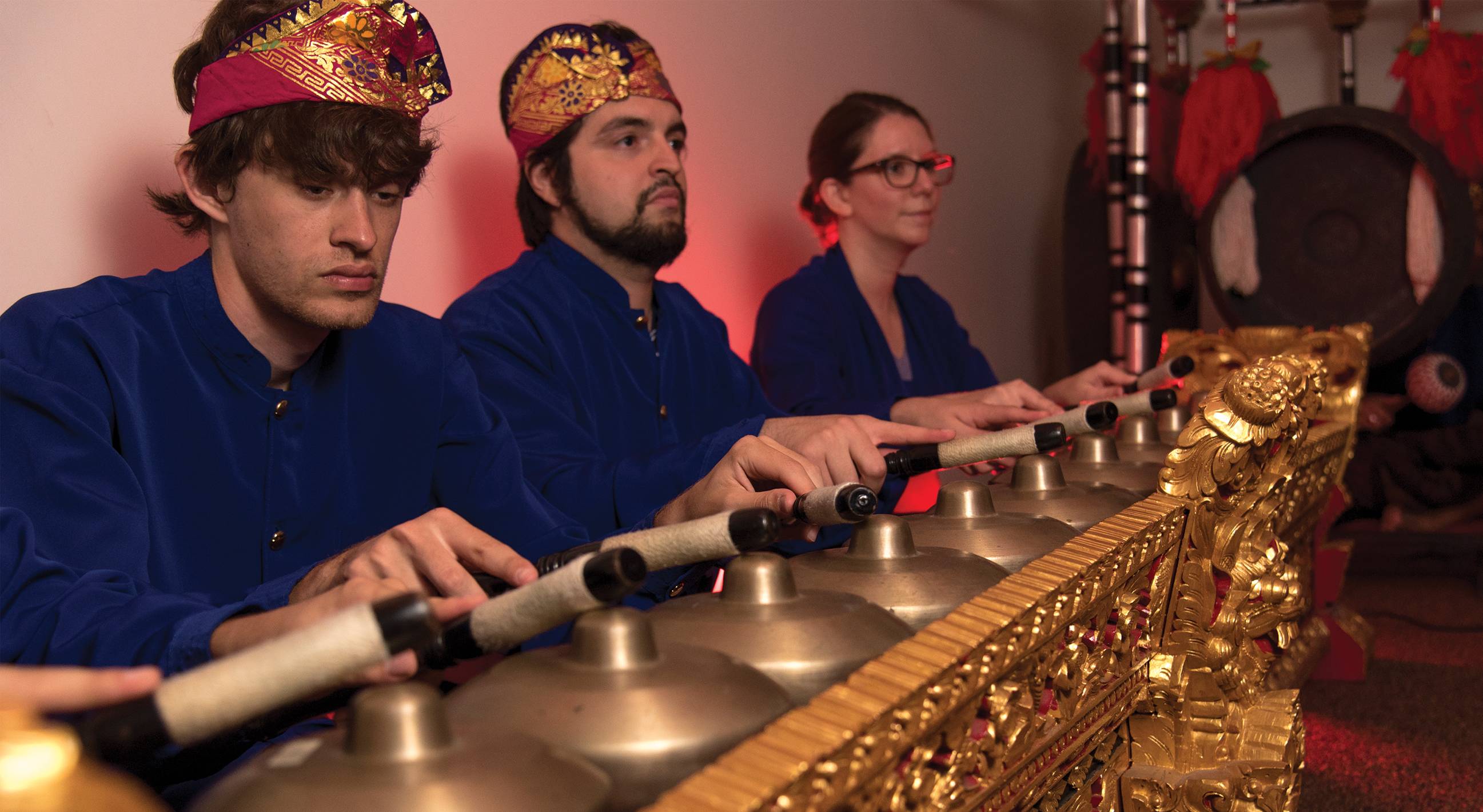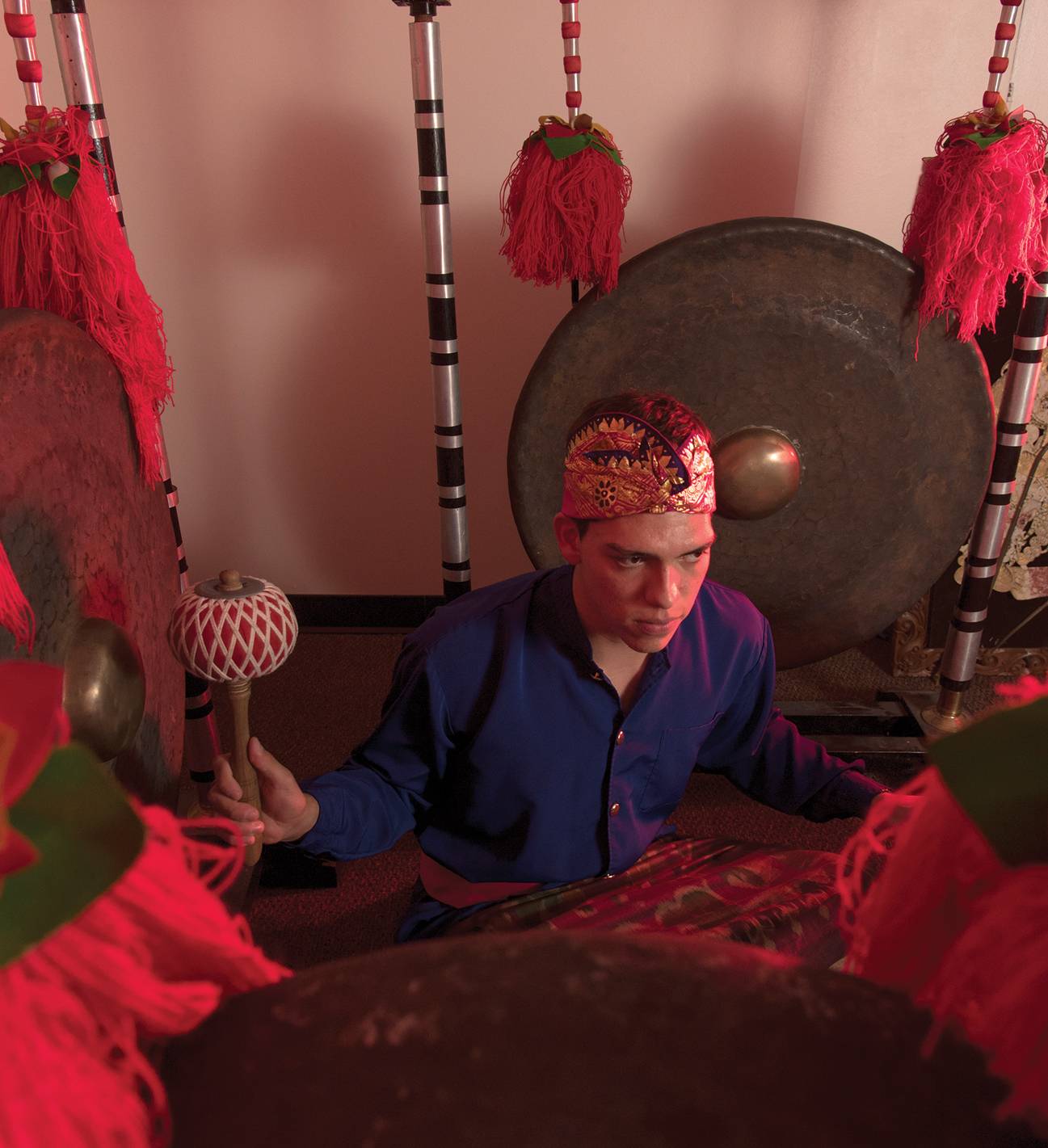
Gongs and metallophones
by David Glessner
Gamelan, the music of Java and Bali, has a dedicated following at Texas State
Like an elaborate chorus of wind chimes, gamelan music is hypnotic and enchanting. Indeed, its exotic allure came calling for young Gordon Jones one night while he was drifting off to sleep in his native Great Britain.
“I first came across gamelan when I was about 20 years old,” says Jones, who is now a senior lecturer and musical director of Gamelan Lipi Awan at Texas State University. “I used to listen to this famous radio DJ named John Peel who would play unique and interesting music on his show every Saturday night. One night, he played gamelan and I sat up in bed and said, ‘Oh, wow!’ ”
"The Balinese don’t really consider it to be art. It’s simply a function, like breathing or eating. Every village, or subset of a village, would have a set of instruments, and people would just get together in the evenings and play."
— Gordon Jones
Indigenous to the islands of Bali and Java in Indonesia, gamelan (pronounced gah-meh-lahn) is a highly percussive music that relies heavily on gongs and metal-keyed instruments called metallophones. The metallophones are played with mallets and can be accompanied by an array of other instruments including hand-played drums, xylophones, bamboo flutes, and bowed or plucked strings. Jones uses the analogy of a tree to explain. “The big gongs are the trunk; the metallophones of various sizes and depth are the branches; and the fast, ornamental, interlocking patterns that add excitement are the flowers,” he says. “It’s technically very difficult (to play), but at the same time, a lot of people who aren’t musicians can take up gamelan. Elements of it are purely physical and very fast, but there are also instruments like the gongs that are necessary to provide the basic structure. The interlocking patterns and how a piece is structured all work together like a big machine that needs to be well-oiled.”
About 24 people make up the full ensemble, which includes students, alumni, faculty, and staff. Dr. Heather Galloway, dean of the Honors College, has been a member since 2013. Claire Cremeens (M.M. ’15), an academic advisor for the College of Liberal Arts, and Andrew McNair (B.M. ’17), are also members. Participants meet every Sunday from 3 to 5 p.m. during the fall and spring semesters.
Gamelan’s core instruments provide the foundation for each ensemble, but geographical regions and cultures can often add subtle variations and distinctions. The music also is inherently social.
“The Balinese don’t really consider it to be art,” Jones says. “It’s simply a function, like breathing or eating. Every village, or subset of a village, would have a set of instruments, and people would just get together in the evenings and play. It’s very communal in the same way that the British might go to the pub and play darts or Texans go to high school football games on Friday night. It’s as much a social community as it is a music ensemble.”
In April, Jones and the Texas State Balinese Gamelan ensemble teamed with the Texas State University Symphony Orchestra at Evans Auditorium to perform one of his original compositions, “Bersama (Coming Together).” The 18-minute piece merged with the pageantry of choreographed dance-drama to create an ornate display of musical theatre. While the free-flowing nature of the music seems to rely on momentum, it is in fact very controlled and methodical.
“It is not improvised at all,” Jones says. “Every piece is set in stone. It’s very rare to have elements of improvisation.”

Before moving to Texas in 2001, Jones taught college-level music for many years in the United Kingdom. Over the course of his career, he has composed many large-scale, music theatre works as well as choral and instrumental ensemble pieces. In addition to teaching in Texas State University’s School of Music and Department of Theatre and Dance, Jones has taught summer workshops for the Austin Chamber Music Center and Austin Lyric Opera. In all, Jones has taught gamelan to more than 25,000 people, including students with special needs, professional musicians, university professors, and kindergartners. The highlights, he said, have been as numerous and varied as his students — and sometimes even humorous.
“Many years ago, I was doing a gamelan workshop with a group of 6-year-old elementary school students,” Jones recalls. “At the end of such a workshop, I would invariably ask the students, ‘When you go home this evening, what will you say you did in school today?’ My hope is to elicit such responses as, ‘We played some music from Bali’ or ‘We played some percussion instruments from Asia.’ On this occasion, a boy raised his hand and said, ‘We had a party!’ That sounded good to me.” ✪